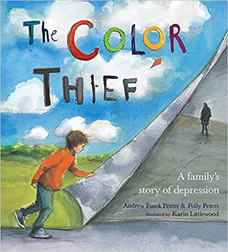The Color Thief
A family’s story of depression
Written by Andrew Fusek Peters and Polly Peters
Illustrated by Karin Littlewood
32 pages
•
Published 2015 (Albert Whitman & Company)

Recommended Age Range: Kindergarten through 3rd grade.
Publisher's Summary:
A child recounts his experience of losing his father to depression in this poignant and beautifully illustrated picture book. The boy’s father disappears into a world without color. As the father seeks help, color begins to reappear and with it hope.

Dr. Annie's Takeaways
Recommended for: This book is well-suited for a child whose parent or loved one is experiencing a depressive episode and is beginning or going through treatment. It describes the emotions that often accompany having a parent with a mood disorder, and it provides hope that a parent’s treatment will help the color return to their world. Includes hospitalization as a component of the father’s treatment.
Would a child like it? It’s a fairly dark book, but having a parent with depression is often a dark experience, and this book validates that. The story is accessible and the ending is hopeful, so a child going through a relevant experience would likely find solace in reading this story with a trusted adult.
Evidence-Based Practices:
Psychoeducation
Tone: Emotionally-resonant, sad but ultimately hopeful
Story Quality: The color thief is a metaphor for depression, stealing color from a person’s world. It’s visually and emotionally effective, and it’s a metaphor that will ring true to many people who have experienced depression. The writing is really lovely–poetic but still accessible to children (e.g., “Soon every day became a sad day for Dad. He only saw the sun sulking, clouds frowning, rain crying…Outside, the trees stood silently, shaking their heads. Dad stayed inside and looked out the window”).
Illustrations: Dream-like watercolor illustrations that lose and regain their color over the course of the story.
Representation: The main characters are a White boy and a White father. A White mother is pictured in one illustration. The family has a dog and a cat and appear to live in a rural area with sprawling green hills.
Psychological Practices: This book shows an authentic picture of a parent with significant depression–the boy’s father feels “sad and stuck, like a marble in a bottle,” and he avoids calls and visitors and stays in bed all day. It also nicely voices the child’s feelings about this change– “I felt lonely. There was a heavy feeling inside me and I missed my dad…I drew a picture of him inside a big ice cube.” The boy’s father goes to see someone at a hospital who talks with him and gives him medicine, and after several months, his father begins to feel better– “The gray shadows in the corners of the room grew smaller…and smaller.” Importantly, the book repeats three separate times, “I thought I had done something wrong, but he told me I hadn’t.” Children often feel responsible for their parents’ moods and this is a very important message to repeat. The book doesn’t use the term depression, so it’s a bit flexible in terms of filling in the diagnosis that fits (e.g., a mood episode within bipolar disorder).
Concerns: The book ends with the dad being back to himself, and “the colors were bright all around us.” Although I appreciate that this book provides hope that treatment will help a parent with depression, it is a little dishonest to suggest that following treatment a parent will be totally “back” without a nod to the fact that depression may continue to rear its head now and then.
